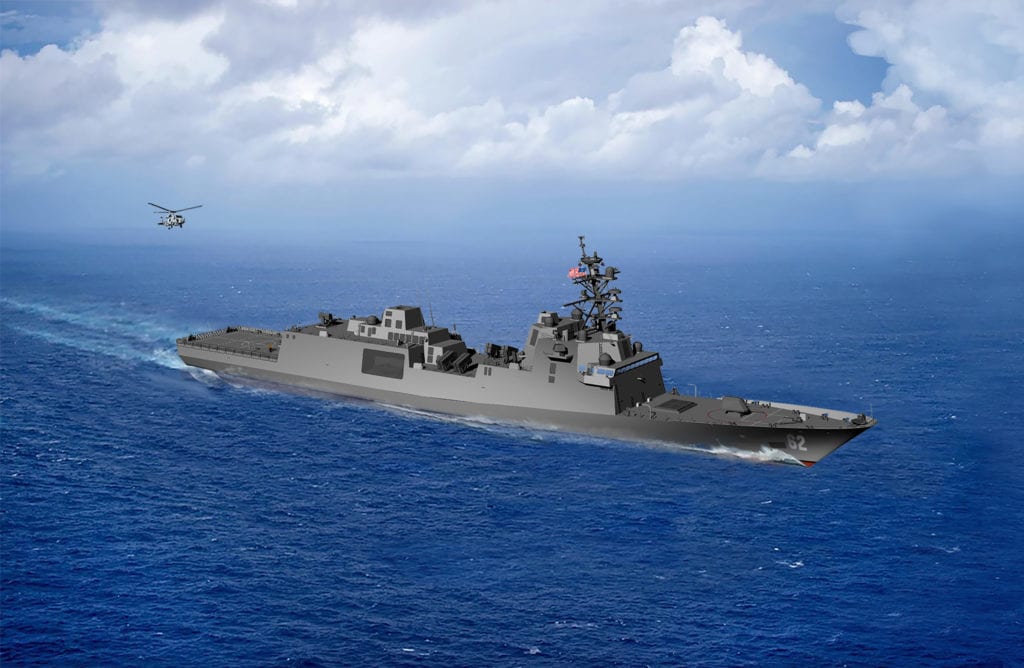
ARLINGTON, Va. — The new frigate being designed and built for the U.S. Navy will operate manned and unmanned helicopters from its flight deck and will be able to add new weapon and aviation capabilities as those systems are developed.
The Navy announced on April 30 that it had awarded a detailed design and construction contract to Marinette Marine of Marinette, Wisconsin, to build the FFG(X) based on Fincantieri’s FREMM frigate design that is in service with the Italian and French navies. Marinette Marine is a Fincantieri company.
See: Urgency, Discipline Hallmarks of Frigate Selection Process, Geurts Says
“This is going to be a real workhorse for the United States Navy supporting distributed maritime operations in the future,” said Vice Adm. Jim Kilby, the Navy’s deputy chief of naval operations for warfighting requirements and capabilities, speaking April 30 during the teleconference for the contract award.
“So, we are super excited about this ship, and I can’t think of a better asset to a strike group or strike group commander to give them the flexibility to do what we need to do in the future.”
Kilby said the frigate “has a requirement for a helo and an unmanned air vehicle but that is not dependent on the landing spot for either one of those. So conceivably, if procured, it could be two helos.”
“This is going to be a real workhorse for the United States Navy supporting distributed maritime operations in the future.”
Vice Adm. Jim Kilby
James F. Geurts, the Navy’s assistant secretary for research, development and acquisition, who also spoke during the teleconference, emphasized service-life allowance and flexibility in the frigate’s future.
Geurts said that growth capability was an important element of the source selection and requirements as the program moves forward.
“That was a design criterion, so we are looking to the future to be able to accommodate all our air vehicles and unmanned vehicles to make this ship what I would call a medium, multimission combatant [so] it can meet all spectrums of potential conflict,” Kilby said.
The FFG(X) will represent a substantial growth in lethality over the Navy’s previous guided-missile frigates, the Oliver Hazard Perry class. The last of those ships was decommissioned in 2015, but the Perry class could accommodate two H-60 anti-submarine helicopters or one H-60 and at least one MQ-8B Fire Scout vertical takeoff unmanned aerial vehicle.
“Understanding how fast the threat is advancing means this service-life allowance requirement is so important for us,” Kilby said. “We did not want to define discretely where we’re going in the future so having some margin to include things such as directed energy [weapons] and other systems is why that’s so important.”
“We have an extensive laser [science and technology] program in the Navy,” he added. “We definitely view it as a requirement for the future as we move into a realm where we want to have our launchers be reserved for offensive weapons and our point-defense systems be rechargeable magazines and the availability for us to sustain them for long periods of time.”
Kilby also said of the new frigate, “Though it’s classified as a small surface combatant, [the FFX(X)] really falls nicely in between our small surface combatants and our large surface combatants, and I see it doing multiple things.”
- SECNAV Advocates Increased Legal Immigration to Increase Shipbuilder Workforce - April 23, 2024
- Insitu Going Strong at 30, Focusing on Maritime Operations - April 8, 2024
- Navy Awards Boeing Additional Funds for MQ-25 Drones for Testing - April 3, 2024






